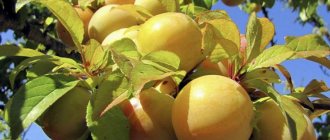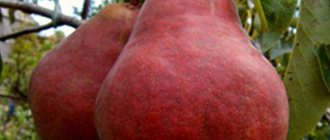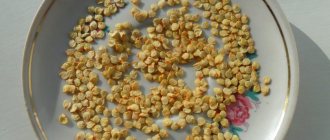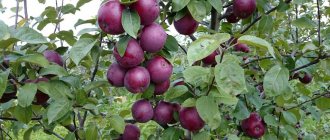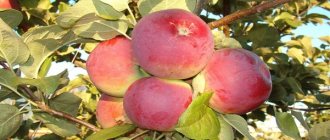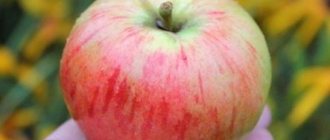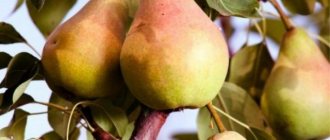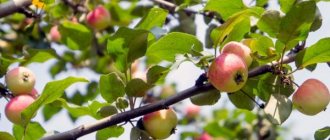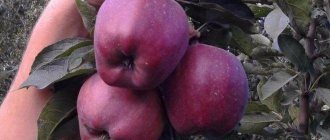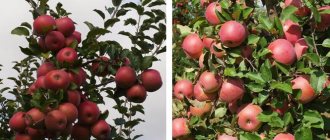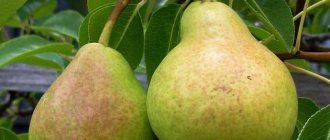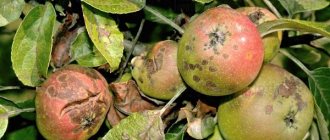The Peach plum variety appeared in our area from Western Europe. Most gardeners grow it in their gardens and vegetable gardens and look forward to each harvest, because the fruits of this plum grow large, juicy and sweet. In addition, Peach Plum is considered an excellent garden decoration.
plum variety "Peach"
variety "Peach" guarantees a bountiful harvest
peach plum delights with a rich peach aroma
How did the variety appear?
No one knows the exact origin of the Peach Plum. It is only known that ownership rights are shared by two countries: France and England. In the meantime, Peach Plum is a variety of Western European origin with early ripening fruits. It has been known since 1830 and has two other names - Royal Rouge and Red Nectarine.
France is considered a more suitable place for breeding this variety due to its climate, but England at that time was making many discoveries in various fields and plant growing was no exception.
If you are also interested in other varieties of plums, you can read this article.
Description and characteristics of peach plum
Like any variety, peach plum trees also have their own distinctive features, by which they can be distinguished from other varieties of plums:
- average value;
- rounded crown with medium foliage;
- thick and powerful branches;
- bark color – brown-gray;
- leaf color – bright green;
- the leaves are large and jagged at the edges;
- blooms late;
- fruits grow on thick petioles;
- the fruits are large;
- weigh up to 70 grams (average weight – 45-50 grams);
- fruit height – up to 4.5 cm;
- width – up to 4.5 cm;
- thickness – up to 4.0 cm;
- the stalk is not thick and short (from 7 to 10 mm);
- shape – round or egg-shaped;
- the skin is thick with a waxy coating;
- the flesh is yellow, dense and elastic;
- the color of the ripe fruit is yellow-green, and one side is reddish;
- the bone is round-oval.
Where does it grow and in what climate?
Peach plum has a summer ripening period, so for good vegetation and active fruiting it needs a lot of sunlight and warmth. Therefore, its habitat is:
- Armenia;
- Azerbaijan;
- Georgia;
- Ukraine (Transcarpathian and Nikolaev regions);
- Moldova.
In Russia, this plum can be found in the following regions:
- Stavropol region
- Krasnodar region;
- Dagestan;
- Ingushetia;
- Rostov region.
Drought and frost resistance
Peach plum is a heat-loving tree - it prefers a mild and warm climate and can easily tolerate summer heat and drought (the main thing is to water it in a timely manner). The level of winter hardiness of the plum is average, as is the level of frost resistance.
In the climate of the Moscow region, Astrakhan and Northern Ukraine, trees can often freeze, so it is important to cover them in winter. And the Peach plum tolerates very harsh and cold winters especially hard.
Pollinators
The Peach plum itself is sterile, so it is necessary that pollinating trees grow within a radius of 12-15 meters from it. At the same time, your attention should be paid directly to early-fruiting varieties: the same flowering period is an important and mandatory factor for high-quality cross-pollination. The following varieties of plums are excellent for this purpose:
- Altana;
- Lodva;
- Mirabelle Nancy;
- Renklod green;
- Hungarian domestic;
- Anna Shpet;
- cherry plum Comet and Lama.
Productivity and fruiting
Peach plum is a fast-growing variety. The first harvests can actually be harvested within 5-6 years from the moment the tree is planted. A stable harvest begins at about 15 years old - during this period, up to 50 kg of an excellent harvest can be collected from one tree.
Resistance to diseases and pests
Peach plum is quite resistant to the destructive influence of pests and diseases, but nevertheless there is a certain list of diseases and parasites that can cause harm to this variety. Proper care and preventive measures can increase the level of resistance to harmful lesions.
Growing and care
Winter hardiness for central Russia is low. This is due to the fact that the variety has a long growing season, the foliage stays on the branches for a long time and the shoots do not have time to ripen before frost. However, compared to, for example, Renklody, it is more frost-resistant, so it should be preferred in areas such as Voronezh or Kursk.
Read also: Louiseania triloba (three-lobed almond): description and cultivation features
The hybrid is not fast-bearing - you will have to wait a long time for the first harvest, 7-8 years after planting. According to reviews, the variety is sometimes affected by fungal diseases, so the trees must be monitored and regularly treated with fungicides.
Peach Michurina is propagated in nurseries by grafting onto winter-hardy rootstocks and ready-made seedlings are sold. They can be easily purchased at garden centers, nurseries and online stores. Some experienced gardeners graft cuttings into the crown of plum trees already on the site. This significantly brings the variety closer to fruiting.
Features of planting peach plum
To plant a plum, you don’t have to spend Herculean efforts - just know simple rules and recommendations, and you will get an excellent result.
Requirements
Since Peach Plum is a heat-loving tree, it needs a place where light and warmth will prevail. Therefore, choose an area with good lighting and sheltered from the north wind. All nearby plantings and buildings should be at least 5 m away. The plum tree needs a lot of free space, then its root system can develop rapidly.
Plants that can be planted next to Peach Plum:
- Apple tree;
- gooseberry;
- currant;
- raspberries.
Plants that should not be planted next to this variety:
- cherries;
- cherry;
- pear.
Soil preparation
The soil should be fertile, sufficiently moist, but so that the moisture does not stagnate. Loam with neutral acidity or chernozem is suitable for this. The presence of groundwater is also of great importance - if its level approaches the surface closer than 1.5 m, then an artificial hill 60 cm high needs to be prepared for the tree. Prepare in advance - in the fall, but a planting hole can be made in the spring in about 2 -3 weeks before planting the seedling.
The hole should be about 70 cm deep and at least 60 cm in diameter. The bottom should be drained with large pebbles, then lay a fertile mixture of:
- 20 cm of topsoil;
- 20 kg of manure;
- 15 kg of coarse river sand;
- 120 g superphosphate;
- 60 g of potassium chloride;
- 300 g ammonium nitrate.
Selection and preparation of seedlings
In order not to make a mistake with the chosen material, pay attention to the following characteristics:
- the seedling must be whole, fresh and without breaks;
- healthy, without signs of disease;
- choose a seedling 1-2 years old;
- make sure that the root system is well developed and closed;
- The height of annual seedlings is 1-1.3 m, and those grown from seeds are 1.5 m.
Each unit of planting material must contain a tag that will indicate all the information about the variety, its manufacturer, breed and favorable growing zone.
Seedlings that were purchased in the fall should be provided with a decent wintering. Choose a place in the garden for the tree and place it at a slight slope with the roots down, in the prepared hole, then cover it with soil until the root system is completely covered and the trunk is covered by a third from the bottom. Cover the top of the seedlings with spruce branches to protect the material from rodents.
Instructions for landing
Take the planting process seriously to ensure that your trees grow in the best conditions in the future. It looks like this:
- Make sure that the seedling is completely intact and remove rotten or dry shoots.
- Place the seedling in a 3% manganese solution on 1-3 trunks for 14 hours.
- Treat the roots with a mixture of manure and clay (ratio of 2 kg of clay to 1 kg of manure and mix until the consistency of thick sour cream), then let dry for 2-3 hours.
- Drive a stake 1.5 m high into the hole at a distance of 10-15 cm from the center.
- Form the soil in the hole into a mound, then place the seedling on top so that the root collar of the plum is 5-8 cm above the final soil level.
- Spread the roots of the cutting. They should be 5 cm from the bottom of the hole.
- Gradually cover the seedlings with soil that was prepared prematurely, carefully laying each layer.
- Fill the planted tree with two buckets of water.
- Remove the stake after two years.
Planting and propagation
The further growth and yield of the plum tree depends on proper planting, so it is important not to make gross mistakes at this stage that will affect the health of the tree.
Pollinator varieties for early fruiting Peach plum
When planning to plant Peach plum, make sure that pollinating varieties are planted nearby.
It is important to select the same early-fruiting neighbors for the Peach Plum so that the flowering period coincides, which is necessary for cross-pollination.
The best varieties for pollination of Peach plum:
- Lodva;
- Hungarian domestic;
- Mirabelle Nancy;
- Anna Shpet;
- Hungarian Azhanskaya;
- Renklod Altana;
- Renklod green.
Cherry plum varieties Lama and Kuban Comet can also become a pollinator for Peach plum.
How to grow plums - video
Rules for planting seedlings
Plum requires fertile soil with a neutral reaction, good breathability and sufficient moisture, but without stagnant moisture. Planting is carried out with 1–2-year-old seedlings with a well-developed root system, intact and smooth bark and living buds.
Plum trees are planted in the middle zone both in spring (April) and autumn (mid-September - October). Autumn planting must be done 1–1.5 months before the soil freezes. If the spring is late, the seedlings have difficulty taking root, get sick and grow poorly.
The further development of the tree depends on the correct planting
You can plant in the spring even those seedlings that you purchased in the fall. To do this, for the winter they need to be buried and covered with spruce branches, then sprinkled with snow to ensure normal wintering. At the end of the cold weather, after the snow melts, it is necessary, without removing the seedlings from the trench, to check their condition for damage by rodents or broken branches. The seedling should be dug up in the spring right before planting (during the period of swelling of the buds).
Spring planting is carried out at the moment the buds begin to swell. You cannot take trees with blossoming leaves for planting - they will most likely die.
Plums should be planted in places that are sheltered from the cold wind and well-warmed by the sun (for example, on the south side of a fence). The plum tree should not be allowed to be shaded by other trees. The lack of light immediately affects the condition of the leaves and fruits: the leaves become pale, and the fruits become less colored and lose their sugar content.
The plum tree requires a certain space, so it is planted at a distance of at least 3 m from other trees.
A planting hole 40–50 cm deep and 65–70 cm wide must be dug in advance (best in the fall, but no less than 12–15 days before planting). A peg is dug in the center of the hole so that it penetrates 15–20 cm into the hard ground, and around it a nutrient mixture is poured to cover 2/3 of the hole’s volume. The soil mixture for filling the planting hole consists of:
- fertile soil;
- 10–25 kg of rotted manure or humus;
- 0.1–0.2 kg of ammonium nitrate;
- 0.2–0.3 kg of potassium chloride;
- 0.5 kg of superphosphate.
In addition, it is recommended to add coarse river sand and a little gravel or broken brick - this improves drainage conditions and increases the heat capacity of the soil. Lime should not be added to the hole, as it can burn the roots. If liming of the soil is required, it should be done in advance, adding 0.5–0.8 kg/m2 of lime before digging.
Sequence of planting Peach plum:
- The plum seedling is placed near the peg on a cone of soil mixture, spreading the roots over it.
- Cover the roots with soil, while lightly pressing the soil with your hands. It is important that the seedling maintains a vertical position, and the root collar remains 4–5 cm above ground level. Deepening the root collar impairs the development of the tree.
- Form a hole and water the tree with 3-4 buckets of water.
- Tie the seedling to the stake with a loop in the shape of a figure eight.
For gartering, it is better to use soft material, for example, a rag rope.
Planting a seedling on video
Reproduction by shoots
How to propagate plum peach shoots? If you wish, this is easy to do yourself. Plum root shoots should be taken from productive trees. It is best to use shoots growing along the border of the tree trunk and well lit by the sun. Plants 1–2 years old are dug up in the fall (September - October) or spring (before the buds open).
- Step back 15–20 cm from the stem and carefully dig out the roots.
- The mother root is cut so that a section of horizontal root 25–30 cm long is separated from the tree.
What care is required?
Planting a tree is only doing half the work, since then the most important thing begins - caring for and maintaining its condition. Caring for the Peach Plum consists of regular fertilization, watering and pruning, loosening the soil and removing weeds - this is the only way to get a healthy tree with large and tasty fruits.
Loosening and watering
Tilling the soil after planting is an important part of subsequent tree care. The tree trunk circle helps provide the tree with air, water and nutrients. The size of the circle should be larger than the size of the crown due to the root system, which grows wider.
To dig up the soil correctly, the surface of the shovel must be placed along the radius of the tree trunk circle, so as not to damage the roots, since they will take a long time to recover. The depth of loosening depends on the distance from the trunk - the closer to the trunk they dig, the shallower the depth should be (7-8 cm), while on the remaining area of the trunk circle this distance should be 10-12 cm.
Watering should be done with extreme caution. It is necessary to water the tree abundantly only during periods of active growth of shoots and during the flowering period (May-June), as well as during the period of ripening of the crop and growth of the root system (August-September).
When watering, it is important not to overdo it, as overwatering can lead to the following consequences:
- the foliage turns yellow and dries out;
- tree growth slows down;
After planting, water the tree once a week with two to three buckets of water. Water an adult plum 5-6 times a season, using 4 buckets of water for each watering.
When the fruits ripen, water even more - 6-8 buckets at a time. If the weather is too hot and dry in the summer, then increase the amount of water at your discretion, since without sufficient watering the fruits will fall off unripe. And in the fall, before preparing for winter, carry out moisture-charging irrigation.
Do not pour water under the tree trunk; to do this, prepare grooves along the outer edge of the circle around the trunk. The ideal option to ensure uniform distribution of water is sprinkling with sprayers.
Fertilizer application
Peach plum takes a large amount of nutrients from the soil, so provide it with regular fertilizing. The time of feeding is associated with the period of pruning the tree. But in the first season, the plum does not need to be fertilized additionally, since it receives all the necessary elements from the soil that was used during planting. However, once every 10 days you can spray the seedlings with growth stimulants - do this in calm weather.
The feeding process occurs as follows:
- Start using urea in the second year, adding 45 g of fertilizer for every 10 liters of water.
- Fertilize with urea when the flowering period begins in a ratio of 45 g per 10 liters of water.
- Add nitrophoska when the fruits begin to ripen, in a ratio of 3 tbsp. l. substances per 10 liters of water.
- When the crop is harvested, add 30 g of potassium sulfate and superphosphate.
- Fertilize with rotted manure (1 bucket per 1 tree) in late autumn.
- Before fertilizing the soil, first water it and loosen it.
Trimming
Starting from the first year of life, the tree needs to be pruned. Do the pruning in such a way that the crown of the tree is formed - this will help accelerate the growth of side shoots, and if you took a seedling at the age of two years when planting, then shorten the branches by 1/3.
3-4 years after planting, young trees begin to grow very quickly - sometimes the growth of shoots in a year can be 2 m. Therefore, all subsequent pruning will be aimed at forming the crown of the tree and will be done before the buds open. Trees are formed in a sparsely tiered system, as this provides access to sunlight to all branches and also makes harvesting more convenient.
Pruning according to the sparse-tier system looks like this:
- Select 5-7 pieces of strong and healthy shoots of skeletal branches so that they grow in all directions.
- Cut the remaining branches into a ring so that the ring-shaped influx is visible, that is, right to the base.
- Place the rows of branches so that there are 3 pieces in the bottom row, 2 in the middle row and 1 branch in the bottom row. Make a distance of 50 cm between branches.
- Cut the central conductor so that it is 20 cm higher than the other branches.
- Cut off any branches that are frozen or withered.
Also use the fruit thinning method. This method helps improve the quality of the resulting crop by reducing its quantity. The first thinning is done when the plums are still the size of a walnut, and the second - when the berries have already doubled in size. The remaining fruit will receive much more sunlight and nutrients, which has a positive effect on the size of the fruit and its taste.
Preparing for frost
To get a good harvest, in addition to performing all the above measures, it is important to take care of the tree’s safe wintering. Temperature changes have a bad effect on Peach Plum - bark burns may appear, and this phenomenon can be seen in February-March, when the difference between the temperature day and night is very large.
For a good wintering of the tree, whitewash the trunk with diluted lime and wrap it in burlap or thick paper. Also, to increase frost resistance, regulate watering and fertilizing - a thick layer of sawdust or peat, at least 25-30 cm, and during severe frosts you can smoke, due to which the air temperature around the seedlings rises by 3-4 degrees.
Winter threats to plum trees also include damping off, when the bark at the bottom of the trunk begins to die. This happens during frosts, which began after heavy wet snow fell, the temperature under which is within 0 degrees. To avoid this situation, it is recommended to trample the snow in the tree trunk circle.
List of possible pests and diseases
Despite the relative resistance to pests and diseases, it is still worth periodically carrying out preventive and therapeutic measures. Plums are most susceptible to moniliosis, rust, marsupial disease and clasterosporiosis.
- Moniliosis or monilial burn - affects the ovaries and leaves - they become brown and dry, and mummification of the fruits also occurs. It is necessary to treat with copper-containing preparations before the buds open. As a preventive measure, do not allow the crown to thicken and carry out timely pruning.
- Marsupial disease - the fruits cannot form seeds and remain empty, and the surface is covered with a coating of spores. It should be treated with a solution of 1% Bordeaux mixture after flowering and at the beginning of fruit ripening. As a preventative measure, prune and destroy infected parts of the tree and collect diseased fruit.
- Clusterosporiosis - leaves are affected by brown spots with a dark border. It is necessary to treat with 3% Bordeaux mixture before and at the end of the growing season. As a preventive measure, prune and destroy infected parts of the tree.
- Rust - red spots appear on the leaves, and the affected foliage falls off. It is necessary to treat with copper oxychloride before flowering. As a preventive measure, collect and destroy fallen leaves.
The following types of insect pests attack plums:
- Winter moth - gathers leaves with a web, eats buds and leaves, gnaws out buds. It is necessary to treat with Lepidocide during the period of bud break. Installing catching belts in the fall helps as a preventative measure.
- Plum codling moth - lays its larvae inside the fruit. Treat with Chlorophos during fruit formation. As a preventative measure, dig up the soil, and then collect and destroy the affected fruits.
- Goldentail - destroys buds and leaves. It is necessary to treat with Benzophosphate during the period of bud extension. As a preventative measure, collect and destroy overwintering nests.
Aftercare for plums
Caring for the Peach plum does not require a lot of effort, time, or resources. Simple recommendations can be easily followed even by a novice gardener:
- Regular watering. During the flowering period (May-June) and fruit ripening (August-September) the soil needs to be thoroughly moistened. After watering, the soil is loosened.
- Fertilizer. To stimulate intensive growth and development of the plant in the fall, it is fed with manure and mineral supplements.
- Trimming. The procedure is necessary to form the crown of the plant. It begins to be carried out from the first year after planting. Annual shoots are shortened by one third.
- Treatment against diseases and pests.
- Preparing for winter. Temperature changes and cold air lead to burns on the plant bark. To avoid such damage, the plum trunk is whitened with diluted lime. Before cold weather, it is covered with special material.
Diseases and pests, methods of control and prevention
| Disease | Description of the lesion | Fighting methods | Prevention |
| Moniliosis | Leaves and shoots dry out. The fruits dry out and disappear | The affected areas are sprayed with copper sulfate | Timely pruning, removal of damaged branches |
| Clusterosporiasis | Brown spotting on leaves and shoots, turning into holes | Using Bordeaux mixture solution | Cutting off part of the affected areas of the tree |
| Rust | Red spots on the foliage. Spoiled leaves fall | Wood is treated with copper oxychloride | Timely destruction of fallen leaves |
How to properly harvest and store crops?
The fruits ripen quite early - flowering occurs already in July, and can be harvested in early August. If you are transporting fruits, start picking them before they are fully ripe (about 3 days before). Do this as carefully as possible - do not drop or wrinkle, so as not to shorten the shelf life. Ripe fruits need to be eaten quickly or sent for processing.
To increase the shelf life of fruits, collect them together with the stalk. Then, for example, at a temperature of 6-7 degrees, the plum can last up to 3 weeks. At low humidity, the fruits quickly wither, and at a temperature of 0 degrees the flesh begins to darken.
Description
The fruits are large, weighing 35-45 grams, round-oval in shape, with a clearly visible seam. The skin color is greenish-yellow, and on the sunlit side there is a delicate pink-red blush with an orange tint.
The pulp is of medium density, repeats the color of the main outer color and has a crispy consistency and a large amount of juice. Sugar content is at the level of southern varieties: 11.1%. The bone is miniature and can be separated without problems. The taste is sweet and sour, pleasant and harmonious, with a peach aroma. It was rated 4.6 out of 5 by tasters.
The purpose is universal; in addition to fresh consumption, the fruits are processed into jams, preserves and high-quality juices. Productivity is average, from 8.5 kilograms from ten-year-old trees that have recently entered fruiting to almost 15 kilograms from more mature specimens. The period of amicable ripening occurs at the end of August - beginning of September. Fruits are not prone to shedding.
Trees are 3.5-4 meters high; vegetative growth occurs especially intensively in young plants. The trunk is covered with smooth bark, the shoots are pubescent, the leaves are large and embossed. Peach Michurina blooms late.
Reviews of peach plum
★★★★★
Dmitry, 52 years old, gardener, Rostov region. Without exaggeration, peach plum is considered a delicious fruit, with a light peach taste.
My wife liked the variety - several fruits that were not yet fully ripe miraculously survived. ★★★★★
Ekaterina, 35 years old, summer resident, Krasnodar. We bought seedlings of this variety many years ago, on the advice of one saleswoman, and since then we have never regretted it.
We waited 5 years for the tree to grow and begin to delight us with its harvests, and soon it happened - we collected 5 buckets of fragrant, tasty and juicy fruits. Very pleased. ★★★★★
Irina, 48 years old, gardener, Vologda. An excellent variety, delicious fruits, but if you grow this plum living in the North-West, then, unfortunately, there will not be much harvest.
Hide
Add your review
Peach plum is able to please its breeders with both its beautiful appearance and a rich harvest. The variety is generally unpretentious - it ripens early, is resistant to pests and diseases, and the ripe fruits are large, juicy and sweet. All these advantages make this variety very popular among gardeners.
0
0
Copy link
Advantages and disadvantages of a precocious tree
Among the advantages of early-fruiting plums, the following should be highlighted:
- early maturation;
- sweet and juicy fruit pulp;
- fruits are large, attractive in appearance;
- abundant harvests;
- high resistance to pests and diseases.
Since the plum harvest is abundant, the tree branches will need additional support
Like any other, this variety is not without its drawbacks. Among the main ones are:
- self-sterility;
- rather low winter and frost resistance;
- with a lack of heat, there is a noticeable deterioration in the quality of the fruit.
